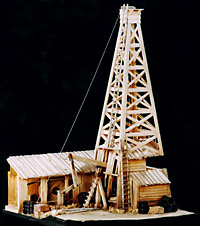
|


|
8. Frontier Resources — Alberta
Oil Rig
|
At the centre of this exhibit is a reconstruction of a cable-tool oil
rig of the 1920s, created with a complete set of original parts on
long-term loan from museums in Alberta and British Columbia. The rig
consists of a wooden derrick tower and a shed housing the cable-tool
drilling rig. The related displays include small-scale models of three
types of drilling rigs used in the past century - spring-pole, cable-tool
and rotary rigs.
The cable-tool rig was in widespread use to drill for oil and gas in Western and Northern Canada from the 1880s to the 1950s. The rigs pounded through soil and rock by repeatedly dropping a heavy iron bit (tool), weighing up to 900 kilograms and attached to a cable. It could take up to two years to complete a well hole, reaching depths of up to 825 metres. A complete rig stood 25 metres high, weighed 34 tons and was made of wood, rope, leather, canvas and iron, making it easy to disassemble and move. This drilling technology was progressively replaced by the more efficient rotary drilling system starting in the 1930s.
Charles Stalnaker: Legendary Well ShooterA display of artifacts, photographs and recorded interviews illustrate the life and times of Charles Stalnaker (1891-1979), who incarnated the rough-and-tumble existence on the early frontiers of natural resource development. Stalnaker was born in West Virginia and worked in the oil fields of Texas, Wyoming and Montana, as well as in Alberta, Saskatchewan and Northern Canada. Starting in 1922, he worked as a well shooter, a famously dangerous trade which used nitroglycerin to break up rock and start the flow of oil wells. Stalnaker became legendary in Western Canada's petroleum industry for his longevity in such a hazardous line of work; he was still "shooting" wells in his early 70s. His reminiscences and anecdotes are captured on a 10-minute video, based on interviews with him recorded in the last decade of his life. On display are a variety of explosive devices and personal effects donated by the Stalnaker family.
New FrontiersPetroleum and natural gas exploration in the West and North are examples of Canada's twentieth-century "frontiers," characterized by rapid economic development, an early "boom and bust" environment, followed by gradual economic diversification. One of the first areas where oil and gas deposits were seriously explored was Turner Valley, Alberta. Turner Valley exemplifies the "boom and bust" cycle experienced by numerous towns built on a single resource industry. The exhibit incorporates one example of economic diversification: the Medalta Potteries Ltd. in Medicine Hat, Alberta, which used natural gas to fire its kilns. From 1916 to 1954, Medalta produced over 900 different products, including a wide range of stoneware, art ware and hotel ware. This enterprise represented Alberta gas, Saskatchewan clays and Ontario capital combining to diversify the Western economy. The current display shows stoneware from the period of 1924-1930 in a factory showroom setting. Drawing on the Canadian Museum of Civilization's extensive collection of Medalta pottery, the display will be periodically changed.
These movies can be viewed with any Quicktime player, but are best viewed using Apple's Quicktime Player. If you wish to download the Quicktime VR Player click on the logo:
Opened: October 12, 2000 |


|



